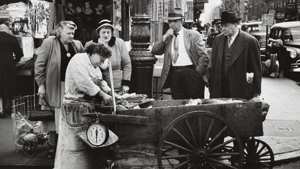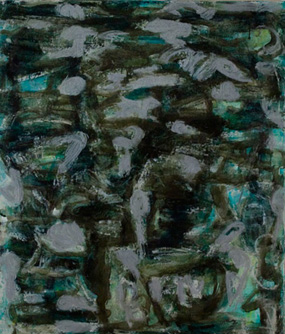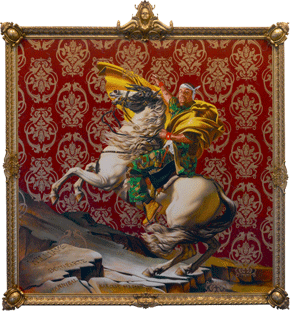Who Needs Them?
John Haberin New York City
The 2020 New York Art Fairs I
Do we really need art fairs? No, really. It just depends on your needs.
Not that anyone needs them all, seemingly year round, year in and year out. I comfort myself that I attend the New York art fairs so that you won't have to, and each year I promise myself will be my last. (For the record, this is my thirteenth straight report on the March fairs.) For now, though, pretend that each fair answers its own need. The trick is to find it, so that you know which need is also yours—and I am here to help. You might then attend just one, but first that nagging question. 
No hurry
To get started on the need for art fairs, need to account for galleries that keep closing? I was delighted to stumble on one such at the ADAA Art Show. Others have made claims for a "hybrid model," with back-room deals and the occasional fair or pop-up, but excuse me if I am still dubious. Will artists stick with a dealer if they cannot get exhibited? Will collectors stay in touch without press, as proof that the artists are worth the money? Can they even keep up?
What if you keep up quite well, thank you? You might still wonder about the art world outside New York, on view at Volta, or you might rather forget galleries altogether, and there are fairs for that as well. You might hate fairs but love the chaos, like a college student facing Spring Break. You may still believe that midlevel galleries matter, for nurturing artists that matter, which leaves at least one fair that matters as well, the Independent. You may have time for one art fair and no more, one as big and blustery as the Armory Show. Oh, and you may just want something that you can afford, at Art on Paper—but allow me to report on that with Frieze online in place of the May fairs no longer on their way.
The Art Show still stands out for its unhurried pace and its exhibitors. Where else could early modern landscapes by John Marin (at Menconi + Schoelkpf) seem a mere prelude to a contemporary return to the industrial America of John Moore (at Hirschl & Adler Modern)? Where else could not one but two galleries (Jonathan Boos and Hirschl & Adler) survey American Surrealism? The show, at the Park Avenue armory, now has more single-artist booths than any fair out there. It can boast of diversity as well, with a Native American, Jeffrey Gibson (at Sikkema Jenkins), and a Palestinian, Jordan Nassar (at James Cohan). Nassar (soon to appear in the Asia Society Triennial) displays a traditional dress face up, which would be spooky enough did he not also turn it into paintings in glitter and black.
The show has so many featured women artists that I lost count, well beyond skies by April Gornik (at Miles McEnery) and a mini-retrospective of Alice Neel (at Cheim & Read). Idris Kahn turns text paintings into floating deep blues, while Ficre Ghebreyesus mixes Cubism with myth. Abstractions include Dorothy Hood in collage (at McClain), Mercedes Pardo Pointe in paint and wood (at Sicardi | Ayers | Bacino), the industrial Minimalism of Charlotte Posenenske (at Peter Freeman), and Helène Aylon (at Leslie Tonkonow) in acrylic on Plexiglas. Coming to Aylon after the Crystal Archives of Walead Beshty (at Petzel), you could well wonder at the border between painting and photography. Judith Eisler gives women cinematic close-ups (at Casey Kaplan), while Beverly Semmes (at Susan Inglett) places them between body imprints and abstraction. Women all but leap off canvas into a carnival for Vanessa German (at Pavel Zoubok).
German is also part of a strong representation of African Americans, like the sophisticated folk art of William Johnson (at Michael Rosenfeld). Adam Pendleton has his letters in spray paint, all the more searing because they are all but impossible to read. Nina Chanel Abney (at Pace Prints) mixes up the whole picture of race in cut paper, with blacks and whites cavorting in a swimming pool or black women framing a Confederate flag. Reality intrudes all too well with a military funeral. For a Latino artist, the art world remains under construction. Ramiro Gomez gives a booth the illusion of unfinished walls (at P.P.O.W.), as a backdrop for men at work.
All the fairs are long on what sells—painting, drawing, and sculpture. They are also short on photography, although the Art Show has New York classics (at Howard Greenberg) and urban landmarks and western dunes in high contrast from Brett Weston (Edward Weston's son, at Danziger). Collectors will just have to wait for the AIPAC photo fair in April. As for video and performance, forget it. Still, the mainstream keeps expanding.
The alternatives
Volta is back in New York after a year, once again sharing VIP admission with the Armory Show a few blocks up the Hudson River. More than ever, too, it is spoiled by success. Its founding premise, single-artist booths, no longer sets it apart—and now it has dropped the requirement anyway. That leaves dealers who could not cut it in Berlin, London, or New York.  Apart from traditional painting in ink by Qin Feng (with Crossing Art), Volta has little more than shiny surfaces. Can it find a reason to survive?
Apart from traditional painting in ink by Qin Feng (with Crossing Art), Volta has little more than shiny surfaces. Can it find a reason to survive?
And then there are the alternative fairs—as alternatives to the dependence of art on big money. Scope still has booths for artists along with little-known dealers, in Chelsea's Metropolitan Pavilion, while a younger fair, Clio, boasts outright of eliminating the middle man. And we all know artists that we wish had representation but do not. In practice, though, it means the clichéd and garish. Photos by Danila Tkachenko of desert people and by Fernando Bayano of male sex workers (both at Mexico's Almanaque and at Scope) have their psychic depths, but depth is not the operative word here. Indifference to the mainstream may produce the very opposite of originality.
For some years now, a Nolita gallery has invited a handful of European and American dealers for fair week, styling itself Salon Zürcher. A trifle affected and not even a fair? All the more so now that Zürcher goes it alone, for eleven women. Still, they work well indeed together as women and as strategies of abstract art. I had encountered before only Emily Berger, with short, dry parallels and the soft tones of a photographic negative, and Claire Seidl, although more for her photographs than her dense painting, almost like undergrowth. It would be cruel to single out others, for all the mysteries of ink stains by Aphrodite Désirée Navab and the horizontal format of Sumayyah Samaha, like episodes in a myth. The single burst into three dimensions, with colorful plastic tubes from Erica Stoller, could serve as a physical gateway onto the rest.
Spring Break turns itself over not to dealers on the one hand nor artists on the other, but to curators, for a true mess—or, as this year's theme has it, excess. The WeWork client of art fairs, it is now on its fourth midtown office space, filling cubicles, offices, common areas, and conference rooms. Painting spills out over walls and floors, and it would take a determined visitor to assign credit where credit is due. One floor's elevator opens onto an image of Jesus that only the greedy have attributed to Leonardo, but it is all in fun. Installations include PCs, but as soft toys in this wild and crazy office, much like the stuffed people and animals elsewhere. They also include at least two beds, a hospital set out for a body scan, and bed linens, just in case you find yourself thoroughly exhausted.
If I could change the whole idea of what it means to be an alternative fair, it would not take an end run around rewarding art and rising stars. It would have European and downtown dealers, rather than the very largest. It would be within blocks of the new gallery cluster in Tribeca. It would have room for such nonprofits as White Column and the New Museum, to remind you of their purpose, and a bookstore called Karma, so that you can laugh at yourself, too. It would not be overwhelming, even on four floors of an elevator building. It would, in short, be the Independent.
Above all, it would have you thinking and questioning. Does Tunji Adeniyi (with Nicelle Beauchene) examine West African identity or the views of others when she pairs black women with a fiery red forest? Which has a more "subversive practice," documentary collage at Richard Saltoun or pronouncements etched (backward) into wood by Barthélémy Toguo (with Galerie Lelong)—and are his carvings more like portrait busts or the office stamps of an oppressive regime? What do smeared abstractions by Richard Kennedy (with Peres) have to do with playing the cello? The fair runs mostly to representation, including soft landscapes by Nathaniel Robinson (with Magenta Plains), gawky women by Margot Bergman (with Anton Kern), and outsider art. They are assertive while still finding their way, because you are, too.
See you in September
A fair whose central meeting point is a champagne bar (priced by the bottle) is not going to reassure critics of the art scene. Nor will one so sprawling that dealers err on the side of scale and pretense, to vie for attention. Two booths with Kehinde Wiley anyone? Lenticular acrylic for the casual silhouettes of Julian Opie (with Cristea Roberts) or monumental childishness by Austin Lee (with Jeffrey Deitch)? "Presents," a ghetto way to the rear for newer galleries at reduced cost, has few indeed of New York's rising dealers. Still, the Armory Show is more varied than ever.
The all-purpose extravaganza has a theater, publications, and no end of eateries. Yet the action lies elsewhere. Newer galleries include Bushwick's Microscope, with its new-media eye on the present. It gives Peggy Ahwesh four screens on the floor, as the entry points denied immigrants, and others on the wall for the 360 degrees of the surveillance state. While the fair no longer has an entire pier for modern as opposed to contemporary art, "Perspectives" takes a quirky view of the past. It has the lush ambition of Pierre Soulage in black (with Archeus), the empty New York of Duane Michals, and safer choices—but also Tim Youd (with Cristin Tierney), who sits right there at a manual typewriter and copies twentieth-century classics. 
"Focus" loosens the requirement of single-artist booths to allow two faces, without losing focus. Robert Nava (with Sorry We're Closed) takes the style and characters of street art to mythic proportions, while Kumasi J. Barnett (with Lowell Ryan) sees African American history a little differently, as The Amazing Black-Man comic books. Augustina Woodgate from Argentina (with Spinello) uses clocks not quite in synch and hourglasses on their sides to allude to issues of inequality, although the objects are more haunting than the allusions. Amir H. Fallah (like Sheida Soleimani, with Iranian parents and also at Denny Dimon) barely hides his Iranian identity under patterned drapery. If the rest of the fair seems routine by comparison, so be it. And that leaves the fair's one big disappointment, its "Platform" projects in common areas.
Much is a little too obvious, like R-rated claymation by Nathalie Djurberg and Hans Berg, as This Is Heaven. The Supreme Court is in session for Edward and Nancy Kienholz, within a white stretch limo, while Dirty Bunny straddles a log for Marnie Weber. Other projects have become murals, which merely blend in. Exhibitors that think big stand out by comparison. Alicja Kwade (with 303) works in copper and coal, like a brass instrument that can resound only in dust, and Liva Isakson Lundin (with Sweden's Wetterling) in stainless steel. Her strip keeps on rolling, back and forth, much like the fairs.
They had hardly opened when the Armory Show had more news: it will not be back on the Hudson River or even in March. Rather, it will move to the Javits Convention Center and to the first weekend after Labor Day. That could be great for attendance. No more trek way west of midtown—and no more walk between piers to take in the art. Instead, the fair can benefit from proximity to Chelsea galleries, the High Line, and a West 34th Street subway stop serving Hudson Yards.
Will competing fairs move to September, too, or will they have to hope for fair-goers three times a year in New York alone, counting May? How will gallery-goers handle it, used to openings en masse that very week? What happens as they move one step closer to a perpetual art fair, year round? Midlevel galleries, short on staff and desperate for sales even before being reduced to "virtual exhibitions" and cautious reopenings after Covid-19, may be hardest hit—and the future of art depends on them. Will they be swamped with collectors spilling over from the fair, or will they drown? Grab your walking shoes while you wait and see.

These New York art fairs ran mostly March 5–8, 2020. Related reviews report on past years, the May art fairs coming up, the 2022 art fairs yet to come, claims for the death of art fairs after Covid-19, and a panel discussion of "Art Fairs: An Irresistible Force?" And do not forget the 2021 art fairs, spring 2022 art fairs, fall 2022 art fairs, spring 2023 art fairs, and fall 2023 art fairs to come.




